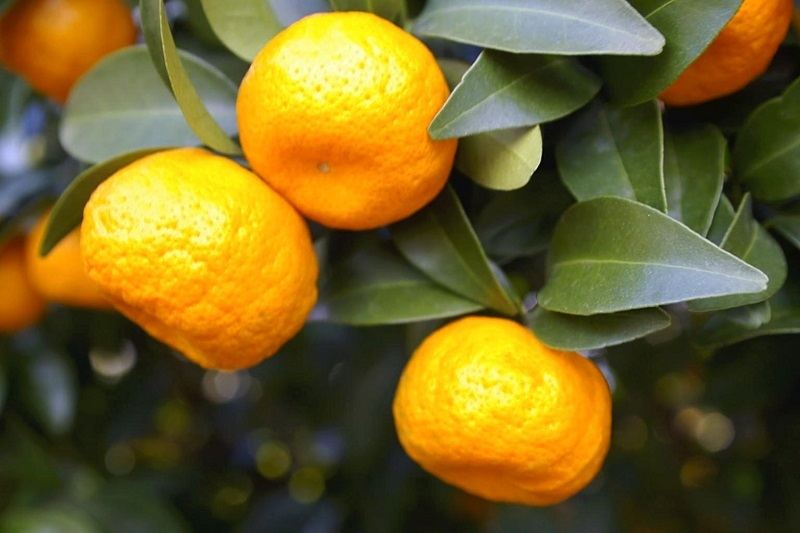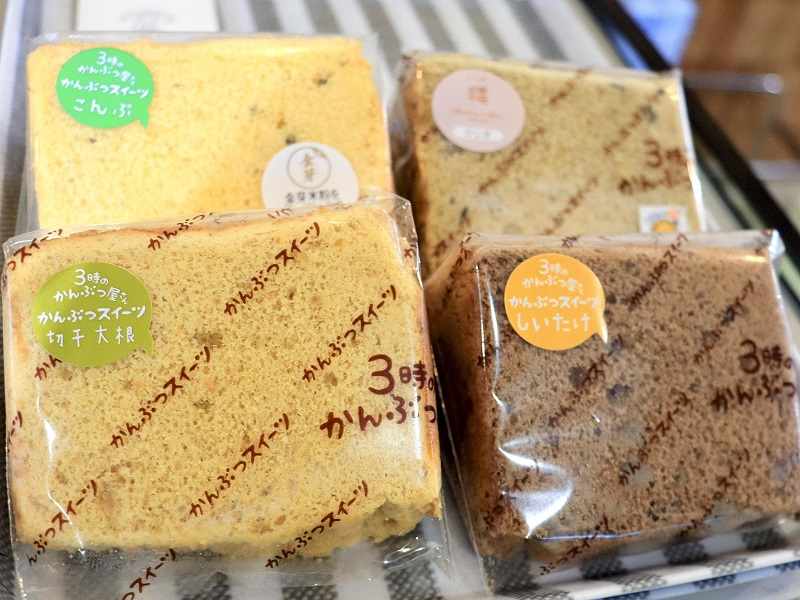May 18, 2022
KAINAN , WAKAYAMA — There is a story surrounding tachibana oranges, which are said to be the origin of sweets in Japan, suggesting that the trees were first planted thousands of years ago in Kainan, Wakayama Prefecture. Based on the tale, the city has been trying to make a name for itself as the “town of sweets.” Local businesses involved in the campaign, which started about seven years ago, have developed various unique sweets using the citrus and other local products.

Courtesy of Wakayama Fruit Tree Experimental Station
Tachibana oranges
The golden yellow fruits are slightly smaller than the popular unshu mikan oranges and are characterized by their sour taste and fresh scent.
According to Environment Ministry data, tachibana orange trees grow naturally in many parts of Japan, but their numbers are dwindling.
Since 2020, dried foods and sweets shop operator Maru San Noda Sho-ten has been using tachibana to make their Kainan Gugelhupf cake. The batter is not only mixed with tachibana oranges but also includes locally produced dried hijiki seaweed.
Gugelhupf, which looks similar to a Bundt cake, is said to have been loved by Marie Antoinette.
“I use tachibana oranges as a way to help promote Kainan as the ‘town of sweets,’” said Tomoya Noda, president of the company operating the shop.
I bought a Kainan Gugelhupf cake at one of the shops operated by the company called Sanji no Kanbutsuya-san. After taking a bite, the refreshing flavor of the tachibana instantly filled my mouth. The soft cake with the tachibana peel and seaweed created a great mix of textures.

The Yomiuri Shimbun
Enchanter sells a wide selection of cakes made with fruits produced in Wakayama Prefecture.
Sanji no Kanbutsuya-san sells other unique goods using dried foods, such as shiitake kakurenbo chiffon cake (shiitake hide-and-seek chiffon cake), which uses chopped dried shiitake mushroom that has been soaked in cocoa, and chiffon cake with kiriboshi daikon (dried daikon strips) and jabara, a citrus from Kitayama, Wakayama Prefecture.

The Yomiuri Shimbun
Chiffon cake made with kiriboshi daikon and jabara, front left, and shiitake kakurenbo chiffon cake, front right, are both made by Maru San Noda Sho-ten.
6 trees, 6 flavors
A butter cake sold by confectionery shop Enchanter is named Ropponju no Oka, meaning a hill with six trees, after the location where it is thought that tachibana orange trees were first planted in Japan. The cake has the phrase, “The origin of sweets is Kainan, the Kishu area!” written on the packaging. Kishu is the former name of Wakayama Prefecture.
Mikan honey, derived from mikan flowers produced in the city, is generously used in the cakes, which come in six flavors, including plum, orange and cherry. The number of flavors was made to match the “six” in Ropponju no Oka.
“The cake is moist and mildly sweet,” said Tomoya Yamaguchi, the owner of the store.
After the product hit the shelves last autumn, “We are seeing more repeat customers,” Yamaguchi said.

The Yomiuri Shimbun
A butter cake made by Enchanter is named Ropponju no Oka, after the location where it is believed that tachibana orange trees were first planted in Japan.
Origin story
Noda and Yamaguchi have both organized and held various confectionery-related events, which were hosted by the city’s tourism promotion association, to make Kainan more well-known.
Their goal is to have residents be proud of their town and be able to tell others, “When you are in Kainan, you will be able to try many delicious sweets.”
Kainan, like many cities nationwide, has an aging population and a declining birth rate. The population decreased from about 70,000 in 1980 to 48,500 as of February this year.
“Sweets have the power to make people happy,” Noda said. “I choose to use that power to revitalize our community.”
The folktale about tachibana orange trees in Kainan is based on descriptions in the Kojiki (Records of Ancient Matters) and Nihonshoki (Chronicles of Japan). According to the texts, a man named Tajimamori no Mikoto was ordered by Emperor Suinin to go on a journey to find Tokijiku no Kagu no Konomi, a food that could make a person immortal. When he finally found it in Tokoyo no Kuni, a utopia, 10 years later, the emperor had already passed away. Tajimamori no Mikoto was so saddened by the news that he died soon after.
It is believed that the tachibana orange was the magical fruit thought to bring immortality. Tajimamori no Mikoto is now revered as a deity of confectionery and is worshipped at Kitsumoto Shrine.
Today, in Kainan, there are six tachibana trees in Ropponju no Oka, which used to be a part of Kitsumoto Shrine, two on the grounds of the shrine located about a 10-minute walk away, and 10 in a field owned by the shrine’s chief priest, Kazunori Maeyama.
Maeyama has provided the fruits to the confectionery shops in the city. “Some say that the Kojiki and Nihonshoki are just myths, but I think the stories are enjoyable,” he said.

